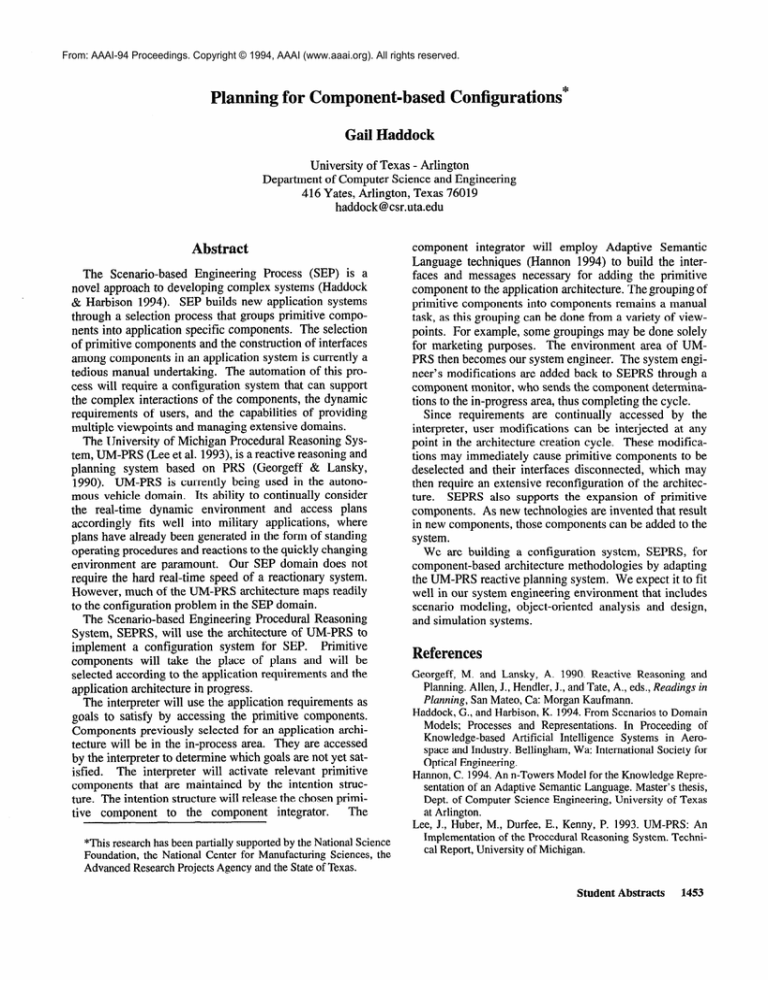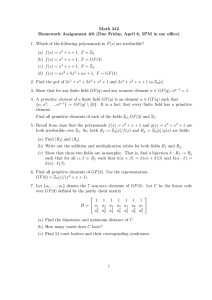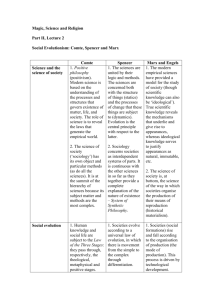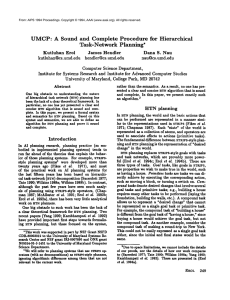
From: AAAI-94 Proceedings. Copyright © 1994, AAAI (www.aaai.org). All rights reserved.
Planning for Component-based
Configurations*
Gail Haddock
University of Texas - Arlington
Department of Computer Science and Engineering
416 Yates, Arlington, Texas 76019
haddock@csr.uta.edu
Abstract
The Scenario-based
Engineering
Process (SEP) is a
novel approach to developing complex systems (Haddock
8z Harbison 1994). SEP builds new application systems
through a selection process that groups primitive components into application specific components.
The selection
of primitive components and the construction of interfaces
among components in an application system is currently a
tedious manual undertaking.
The automation of this process will require a configuration system that can support
the complex interactions of the components, the dynamic
requirements
of users, and the capabilities of providing
multiple viewpoints and managing extensive domains.
The University of Michigan Procedural Reasoning System, UM-PRS (Lee et al. 1993), is a reactive reasoning and
planning
system based on PRS (Georgeff & Lansky,
1990). UM-PRS is currently being used in the autonomous vehicle domain. Its ability to continually consider
the real-time dynamic environment
and access plans
accordingly
fits well into military applications,
where
plans have already been generated in the form of standing
operating procedures and reactions to the quickly changing
environment
are paramount.
Our SEP domain does not
require the hard real-time speed of a reactionary system.
However, much of the UM-PRS architecture maps readily
to the configuration problem in the SEP domain.
The Scenario-based
Engineering Procedural Reasoning
System, SEPRS, will use the architecture of UM-PRS to
implement a configuration
system for SEP. Primitive
components
will take the place of plans and will be
selected according to the application requirements and the
application architecture in progress.
The interpreter will use the application requirements as
goals to satisfy by accessing the primitive components.
Components previously selected for an application architecture will be in the in-process area. They are accessed
by the interpreter to determine which goals are not yet satisfied.
The interpreter will activate relevant primitive
components that are maintained by the intention structure. The intention structure will release the chosen primiThe
tive component
to the component
integrator.
*This research has been partially supported by the National Science
Foundation, the National Center for Manufacturing Sciences, the
Advanced Research Projects Agency and the State of Texas.
component
integrator will employ Adaptive Semantic
Language techniques (Hannon 1994) to build the interfaces and messages necessary for adding the primitive
component to the application architecture. The grouping of
primitive components into components remains a manual
task, as this grouping can be done from a variety of viewpoints. For example, some groupings may be done solely
for marketing purposes.
The environment
area of UMPRS then becomes our system engineer. The system engineer’s modifications are added back to SEPRS through a
component monitor, who sends the component determinations to the in-progress area, thus completing the cycle.
Since requirements
are continually
accessed by the
interpreter, user modifications
can be interjected at any
point in the architecture creation cycle. These modifications may immediately cause primitive components to be
deselected and their interfaces disconnected,
which may
then require an extensive reconfiguration
of the architecture. SEPRS also supports the expansion of primitive
components.
As new technologies are invented that result
in new components, those components can be added to the
system.
We are building a configuration
system, SEPRS, for
component-based
architecture methodologies by adapting
the UM-PRS reactive planning system. We expect it to fit
well in our system engineering environment that includes
scenario modeling, object-oriented
analysis and design,
and simulation systems.
eferences
Georgeff, M. and Lansky, A. 1990. Reactive Reasoning and
Planning. Allen, J., Hendler, J., and Tate, A., eds., Readings in
Planning, San Mateo, Ca: Morgan Kaufmann.
Haddock, G., and Hat-bison, K. 1994. From Scenarios to Domain
Models; Processes and Representations.
In Proceeding of
Knowledge-based
Artificial Intelligence
Systems in Aerospace and Industry. Bellingham, Wa: International Society for
Optical Engineering.
Harmon, C. 1994. An n-Towers Model for the Knowledge Representation of an Adaptive Semantic Language. Master’s thesis,
Dept. of Computer Science Engineering, University of Texas
at Arlington.
Lee, J., Huber, M., Durfee, E., Kenny, P. 1993. UM-PRS: An
Implementation of the Procedural Reasoning System. Technical Report, University of Michigan.
Student Abstracts
1453






